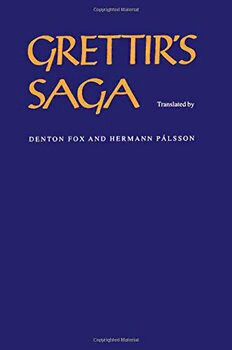
Grettir’s Saga PDF
Preview Grettir’s Saga
QRETTIR'S SAQA University of Toronto Press QRETTIRS SAQA Translated by Denton Fox and Hermann Pálsson ©University of Toronto Press 1974 Toronto Buffalo London Printed in the United States of America ISBN cloth 0-8020-1925-0 ISBN paper 0-8020-6165-6 lc 72-90746 Reprinted 1977, 1981 photographs by James Rupert Norquay Contents Introduction vii A note on the translation xiv Plates xv Grettir’s Saga 3 Maps 188 A note on the social and legal background of the saga 193 Index of proper names 197 Introduction Grettir's Saga is the last of the great Icelandic sagas: it was probably written about 1325, some thirty or forty years after Njal's Saga, and at the end of the hundred years during which most of the important sagas were written. Its author was evidently a man of great knowledge and sophistication; the saga shows that he had mastered both the matter and the literary techniques of the earlier sagas.1 Grettir s Saga is one of the longest, most profound, and most unorthodox of the sagas. This work has sometimes been thought of as a crude folktale filled with monsters and blind violence, an example of the sort of rough and popular material which must have lain behind Beowulf. But in fact it is more like Beowulf itself; although some of the elements of the saga are the kind of stuff one finds in folktales, the structure of the work is highly wrought, and its meaning intricate. Its art is self-concealing; in particular, its structure seems, deceivingly, to be rambling and naive, a chronicle of a series of disconnected events. The author, however, planned his work with great care; 1 The saga writer’s borrowings from earlier sagas can be seen from the ref erences he makes to them in the text itself. He mentions Laxdœla Saga (chapter 10), Bandamanna Saga (‘The Saga of the Confederates,’ chapter 14), Bjarnar Saga Hitdœlakappa (chapter 58), The Saga of Bodmod, Grimolf and Gerpir (chapter 12), and Earl Eirik's Saga (chapter 19). Also there is ample evidence to show that the author was heavily indebted to a number of other sources, though he fails to acknowledge them. The first eight chapters are freely adapted from Landnámabók (‘The Book of Settlements'), and a great deal of other genealogical detail is derived from that source. Chapters 25-7 are based on Fóstbrœðra Saga (‘The Sworn- Brothers’ Saga’). Other works used by the author include HeiJarviga Saga, Eyrbyggja Saga, Kristni Saga, Htingrvaka, Islendingabók (‘The Book of the Icelanders’), EgiTs Saga, Njal's Saga, Vatnsdœla Saga, Kormak's Saga, and finally some version of the story of Tristram and Iseult. See Guðni Jónsson’s introduction to his edition of Grettir's Saga in the fslenzk Fornrit series. perhaps the best way to grasp the meaning of the saga is to look briefly at the way it is put together. The saga falls into three unequal parts: a prologue of thirteen chapters; the main body of the saga, seventy-one chapters describing Grettir’s life and death; and an epilogue of nine chapters. The prologue, like the epilogue, appears at first to have only a slight relevance to the central part of the saga but, again like the epilogue, it is in fact an organic part of the whole. On the level of plot, the excuse for the prologue is that it describes some of Grettir’s ancestors, and tells how his family moved from Norway to Iceland. These chapters also help us to understand Grettir’s character, because some of the salient features in his make-up are inherited from his forebears. His recalcitrance, for example, reminds us of his father as a young man. But, on a thematic level, the prologue is much more significant. The central action in this part of the story is the exodus from Norway, where the newly established kingdom seemed increasingly oppressive, to the anarchic and completely individual istic violence of viking life, and finally to the virgin country of Iceland, a country which offered the possibility, at least, of men living together in an organized society while still preserving their individual freedom. The central character, and the one who epito mizes this part of the saga, is Onund Tree-Foot, whom we discover later to be Grettir’s great-grandfather. After a turbulent and chaotic life he settled in Iceland: the journey cost him a leg, and, as he says, he traded his cornfields in Norway for icy Kaldbak (‘Cold-Ridge’), but he never flinched or compromised. The author of the saga looks back from the fourteenth century, when Iceland was no longer an independent country, to the violent and lawless time of the vikings in the ninth century, then to the period of settlements in Iceland, and finally to the first half of the eleventh century, the time of the central part of the saga. The saga continually reveals the author’s concern with the conflict between man’s desire for individual freedom and the restrictive bonds imposed by society. The flight from Norway to Iceland, from sub jection and confinement to a perilous freedom beset both by the external hazards of a new land and by the internal hazards of loneliness and pride, is partly a parallel of the main action of the saga, Grettir’s escape to freedom and destruction. But the prologue closes at the time when Christianity was being introduced into Iceland, and here a new element enters. Onund’s career, as a heroic and individualistic warrior in a chaotic world, had its own propriety; Grettir’s character is like a larger version of Onund’s, but he is born too late, and into a Christian and civilized world, where theVlll Vlll
